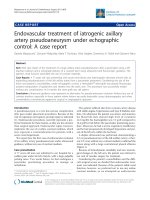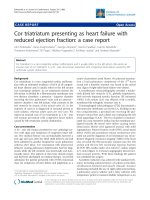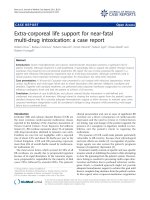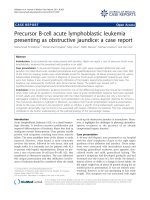Báo cáo y học: "Endovascular treatment of iatrogenic axillary artery pseudoaneurysm under echographic control: A case report" potx
Bạn đang xem bản rút gọn của tài liệu. Xem và tải ngay bản đầy đủ của tài liệu tại đây (1011.31 KB, 4 trang )
CAS E REP O R T Open Access
Endovascular treatment of iatrogenic axillary
artery pseudoaneurysm under echographic
control: A case report
Daniela Mazzaccaro
*
, Giovanni Malacrida, Maria T Occhiuto, Silvia Stegher, Domenico G Tealdi and Giovanni Nano
Abstract
Aim: Brief case report of the treatment of a large axillary artery pseudoaneurysm after a pacemaker using a left
brachial cutdown and a retrograde delivery of a covered stent using ultrasound and fluoroscopic guidance. The
patient’s renal function precluded the use of contrast materials.
Case Report: A 77 years old man presenting with acute renal failure and haemoglobin decrease arrived with an
expanding pseudoaneurysm of the left axillary artery from a pacemaker placement. Considering the site of the
lesion and patient’s comorbidities, under echographic control, a Hemobahn
®
stent-graft was placed; fluoroscopy
assisted manipulation of guidewires and sheaths into the aortic arch. The procedure was successfully ended
without any complications. At 8 months the stent graft was still patent.
Conclusion: Ultrasound guidance may represent an alternative for pseudo-aneurysm exclusion without any use of
contrast medium, especially in those patient where lesions are easily detectable using ultrasonography and when
comorbidities contraindicate aggressive surgical or angiographic approach.
Introduction
A pseudoaneurysm is a rare but serious complication
after pace-maker placement procedures. Because of the
risk of expansion and rupture, prompt repair is indicated
[1]. Endovascular procedures currently represent a pre-
ferred treatment for these lesions, as they are less invasive
than surgical approach. Endovascular repair, however,
implicates the use of a iodine contrast medium, which
may r epresent a contraindication for patients with a
severe renal impairment.
We report here the first case of endovascula r exclusion
of an axillary artery pseudoaneurysm under ultrasound
guidance, without any use of contrast medium.
Case presentation
A 77 years old man was admitted to our hospital for a
sudden pain under his left clavicle, with a large palpable
pulsing mass. Two weeks before, he had undergone a
pacemaker positioning procedure to manage an
arrhythmia.
The patient suffered also from coronary artery disease
with stable angina, hypertension and type II diabetes mel-
litus. On admission the patie nt was anuric and anaemic;
his blood lab-tests showed high level of creatinine
(4.2 mg/dl); his haemoglobin was 7.2 g/dl compared to
12.4 g/dl he had before the pacemaker positioning proce-
dure. Moreover, he had a severe respiratory insufficiency
and he had progressively developed hypostenia and par-
esis of his left arm within the last hour.
A duplex ultrasound was per formed, dem onstrating a
5.2 cm pseudoaneurysm of the left axillary artery; a thor-
acic CT-scan without any contrast medium confirmed the
lesion along with a large contralateral pleural effusion
(Figure 1).
Because of hemodynamic instability and new neurolo-
gical changes in the left arm, the patient was referred to
our unit of vascular surgery for treatment.
Considering t he patient’s comorbidities and the diffi-
cult surgical access we decided that endovascular treat-
ment was indicated. Because of the patient’slabilerenal
function, however, we preferred not to use any iodine
contrast medium, so we attempted an endovasc ular
* Correspondence:
University of Milan, Italy. 1
st
Unit of Vascular Surgery, IRCCS Policlinico San
Donato, 20097 San Donato Milanese (MI), Italy
Mazzaccaro et al. Journal of Cardiothoracic Surgery 2011, 6:78
/>© 2011 Mazzaccaro et al; licensee BioMed Cent ral Ltd. This is an Open Access article distributed under the terms of the Creative
Commons Attribution Licen se ( , which permits unrestricted use, distribution, and
reprodu ction in any medium, provided the original work is properly cited.
exclusion under echographic guidance. An informed
consent was obtained by the Patient.
MyLab™ 25 X-Vision scan (Esaote S.p.A. Firenze,
Italy) with a linear 7-10 MHz probe was used for inso-
nation of axil lary, subclavian and vertebral arteries. Pre-
operative duplex showed the entry point of the lesion
and proximal and distal diameter of the axillary artery
of 7 and 7.2 mm respectively (Figure 2).
Under loco-regional anesthesia the brachial artery was
cannulated in a retrograde fashion with a 5F sheath
after surgical exposure. Fluoroscopy was used to assist
manipulation of a 0.035-in. hydrophilic guidewire into
the aortic arch. Then it was exchanged over a 4F cathe-
ter to a 0.020-in. stiff wire (Boston Scientific M editech)
in order to give more support to the entry of the stent-
graft. Intraoperative duplex confirme d the proximal and
distal diameter of the axillary artery of 7 and 7.2 mm
respectively. A 9 × 50 mm Gore Hemobahn
®
(W.L.
Gore Associates, Inc., Flagstaff, AZ, USA) stent-graft
was then chosen; this graft is a 0.020” compatibl e device
with a diameter that oversized 20% the vessel diameter.
After removal of the 5F sheath, under fluoroscopy, the
device was advanced throughout the brachial artery
without any sheath due to the inability to advance the
proper 9F sheath in such a little vessel. Then, under
ultrasound guidance, it was placed across the neck of
the pseudoaneurysm and deployed when the correct
position was achieved.
No post-dilation was necessary.Nointraoperative
complications were observed.
During the first post-operatory day, the patient
received a blood transfusion. His clinical condition gra-
dually improved, and an echographic scan in the third
post-operative day showed the complete exclusion of
the sac and vessel good patency (Figure 3).
He was discharged five days later with a normal renal
function and haemoglobin blood level of 10.4 g/dL.
Eight months later a contrast-enhanced CT-scan control
confirmed the complete exclusion of the sac in absence of
any endoleaks, and an ultrasound evaluation excluded any
flow impairment during upper limb movements.
Discussion
Iatrogenic axillary artery pseudoaneurysms are uncom-
mon complications of many invasive manoeuvres by
transbrachial approach [1]. As re ported in literature, the
incidence of iatrogenic pseudoaneurysms ranges from
0.1 to 6% [2], but the number of upper limb pseudoa-
neurysms is even lower (less than 2% of all lesions) [1].
The therapeutic practice in the management of iatro-
genic pseudoaneurysms has changed over the last dec-
ade. A conventional surgical approach in the axillary
area may be associated with many complications, such
as major blood loss and potential damage of adjacent
neurovascular structures. The surgical inaccessibility of
axillary arteries makes endovascular procedure like stent
graft p lacement or thrombin injection particularly
attractive [1,3,4].
Figure 1 Preoperative CT-scan.
Figure 2 Duplex scan control.
Figure 3 Post-operative Duplex ultrasound control assessing
the complete exclusion of the lesion.
Mazzaccaro et al. Journal of Cardiothoracic Surgery 2011, 6:78
/>Page 2 of 4
In our case, the lack of significant published experi-
ence with thrombin injections in axillary artery pseudoa-
neurysms [5], the difficult surgical exposure and the
associated patient’s comorbidities, especially renal fail-
ure, have meant that endovascular repair with a covered
stent using sonographic control was the approach of
choice.
Considering the anatomy of the involved district, an
open surgical approach would have need an anterior thor-
acotomy above the nipple in the left third or fourth inter-
costal space [6] with a potential sternotomy to obtain a
better exposure and proximal control, but this approach
wouldhaveworsenedthepatient’ s already impaired
respiratory function. As an alternative, a supraclavicular
incision with a transection of the clavicle would have been
required, implying a greater post-operative pain and a
longer post-operative course [7].
As for ultrasound-guided thrombin injection, Hirsch et
al. [3] presented an approach to the management of
catheter-related femoral artery pseudoaneurysms: in the
reported algorithm, non -operati ve interve ntion such as
U.S guided compression or thrombin injection are not
the option of choice in presence of a symptomatic pseu-
doaneurysm which is rapidly expanding, causing nerve
compression. As there are no clear guidelines about the
treatment of axillary district pseudoaneurysms, we
referred to this algorithm, so thrombin injectio n was
avoided because of the presence of neurological compres-
sion by the hematoma that was progressively enlarging.
Some case reports [8-10] have demonstrated the feasibil-
ity of endovascular treatment of an axillary aneurysm until
now. In our Centre, 12 endovascular treatment of subcla-
vian-axillary arteries aneurysms have been performed for
the last five years, using traditional endovascular methods
and with good technical and cl inical results. Because of
important acute renal failure, in this particular case a less
invasive approach was preferred, treating the patient with
endovascular technique under ultrasound guidance. Using
echography., the apposition of the stent-graft to the vessel
wall could likely be assessed as well; to our knowledge,
this report is the first case of an endovascular treatment
for axillary pseudoaneurysm ultrasound-guided.
The fist decision concerned the access. To avoid the use
of any contrast material, we preferred surgical exposure of
the brachial artery with a retrograde approach to the
lesion. This approach permitted an easy placement of the
guide wire in the aort ic arch with a very low risk of
embolic cerebral events due to manipulation in a very cal-
cified aortic arch, even if it required a surgica l cut. Some
authors [11] proposed a pre-operatory contrast-MRI eva-
luation of the aortic arch in order to avoid difficult man-
oeuvres and large co nsume of contrast medium during
supra-aortic vessels cannulation, above all in case of a
bovine conformation; as some past and recent studies [12]
reported about the role of gadolinium in t riggering renal
insufficiency, we preferred, in this particular case, a bra-
chial retrograde approach, which probably w as the best
option also considering the clinical emergency.
The second issue was about the choice of the stent-
graft. In our institution, three stent-graft are always
available: Fluency Plus
®
(Bard Peripheral Vascular Inc,
Tempe, Az, USA), Wallgraft
®
(Boston Scientific, San
Francisco, CA, USA) and Hemobahn
®
(W.L. Gore
Associates, Inc., Flagstaff, AZ, USA.). Fluency device did
not fit our lesion because of his strong radial force (not
recommended for joint positioning) and the presence of
flared bare stents (in our experience dangerous for the
vessel wall). In order to avoid shortening of the device, a
Gore Hemobahn
®
graft was chosen instead of Wall-
graft
®
. The main disadvantage of this stent is in fact
shortening, which makes precise placement difficult.
Thethirdissueconcernedthefollow-up.Inthiscase
the normalisation of renal function permitted the execu-
tion of a CT-scan with contrast medium, but maybe a
simple Duplex scan would have been satisfactory alike.
Some authors reported a significant intimal hyperplasia
at follow-up, especially in case of repair of traumatic
axillary artery pseudoaneurysms [13]; in our case how-
ever, placing a covered stent was probably the best ther-
apeutical choice, even if a so highly mobile artery could
be prone to neointimal proliferation and stent occlusion.
Conclusions
Ultrasound guidance may represent an alternative for
pseudo-aneurysm exclusion without any use of contr ast
medium, especially in those patient where lesions are
easily detectable using ultrasonography and when
comorbidities contraindicate aggressive surgical or
angiographic approach.
IRB Approval
Our institution approved the report of this case.
Consent
Written informed consent was obtained from the patient
for publication of this case report and accompanying
images. A copy of the written consent is available for
review by the Editor-in-Chief of this journal.
Authors’ contributions
DM participated in the design of the case report and performed the search
in the literature.
GM, MTO, SS, DGT, GN participated in the design and coordination of the
report.
All authors read and approved the final manuscript.
Competing interests
The author declares that they have no competing interests.
Mazzaccaro et al. Journal of Cardiothoracic Surgery 2011, 6:78
/>Page 3 of 4
Received: 25 January 2011 Accepted: 27 May 2011
Published: 27 May 2011
References
1. Szendro G, Golcman L, Klimov A, Yefim C, Johnatan B, Avrahami E,
Yechieli B, Yurfest S: Arterial false aneurysm and their modern
management. Isr Med Assoc J 2001, 3(1):5-8.
2. Görge G, Kunz T, Kirstein M: Non-surgical therapy of iatrogenic false
aneurysms. Dtsch Med Wochenschr 2003, 128(1-2):36-40.
3. Hirsch AT, Haskal ZJ, Hertzer NR, Bakal CW, Creager MA, Halperin JL,
Hiratzka LF, Murphy WR, Olin JW, Puschett JB, Rosenfield KA, Sacks D,
Stanley JC, Taylor LM Jr, White CJ, White J, White RA, Antman EM, Smith SC
Jr, Adams CD, Anderson JL, Faxon DP, Fuster V, Gibbons RJ, Hunt SA,
Jacobs AK, Nishimura R, Ornato JP, Page RL, Riegel B: ACC/AHA 2005
Practice Guidelines for the management of patients with peripheral
arterial disease (lower extremity, renal, mesenteric, and abdominal
aortic): a collaborative report from the American Association for Vascular
Surgery/Society for Vascular Surgery, Society for Cardiovascular
Angiography and Interventions, Society for Vascular Medicine and
Biology, Society of Interventional Radiology, and the ACC/AHA Task
Force on Practice Guidelines (Writing Committee to Develop Guidelines
for the Management of Patients With Peripheral Arterial Disease):
endorsed by the American Association of Cardiovascular and Pulmonary
Rehabilitation; National Heart, Lung, and Blood Institute; Society for
Vascular Nursing; TransAtlantic Inter-Society Consensus; and Vascular
Disease Foundation. Circulation 2006, 113(11):e463-654.
4. Kumar RM, Reddy SS, Sharma R, Mahajan R, Talwar KK: Endovascular repair
of a traumatic axillary artery pseudoaneurysm. Cardiovasc Intervent Radiol
2009, 32(3):598-600.
5. Elford J, Burrell C, Roobottom C: Ultrasound guided percutaneous
thrombin injection for the treatment of iatrogenic pseudoaneurysms.
Heart 1999, 82:526-527.
6. Rich NM, Mattox KL, Hirshberg A: Vascular Trauma. 2 edition. Elsevier
Saunders; 2004.
7. Lin PH, Koffron AJ, Guske PJ, Lujan HJ, Heilizer TJ, Yario RF, Tatooles CJ:
Penetrating injuries of the subclavian artery. Am J Surg 2003,
185(6):580-4.
8. Marston WA, Criado E, Mauro MA: Transbrachial endovascular exclusion of
an axillary artery pseudoaneurysm with PTFE-covered stent. J Endovasc
Surg 1995, 2:172-176.
9. Sullivan TM, Bacharach JM, Perl J, Gray B: Endovascular management of
unusual aneurysms of the axillary and subclavian arteries. J Endovasc
Surg 3(4):389-395.
10. Vijayvergiya R, Kumar RM, Ranjit A, Grover A: Endovascular management
of isolated axillary artery aneurysm. Vasc Endovasc Surg 2005,
39(2):199-201.
11. Ascher E, Hingorani AP, Marks NA: Duplex-assisted internal carotid artery
baloon angioplasty and stent placement. Perspect Vasc Surg Endovasc Ther
2007, 19(1):41-7.
12. Solomon GJ, Rosen PP, Wu E: The role of gadolinium in triggering
nephrogenic systemic fibrosis/nephrogenic fibrosing dermopathy. Arch
Pathol Lab Med 2007, 131:1515-16.
13. Onal B, Ilgit ET, Kosar S, Akkan K, Gümüs T, Akpek S: Endovascular
treatment of peripheral vascular lesions with stent-grafts. Diagn Intervent
Radiol 2005, 11(3):170-174.
doi:10.1186/1749-8090-6-78
Cite this article as: Mazzaccaro et al.: Endovascular treatment of
iatrogenic axillary artery pseudoaneurysm under echographic control: A
case report. Journal of Cardiothoracic Surgery 2011 6:78.
Submit your next manuscript to BioMed Central
and take full advantage of:
• Convenient online submission
• Thorough peer review
• No space constraints or color figure charges
• Immediate publication on acceptance
• Inclusion in PubMed, CAS, Scopus and Google Scholar
• Research which is freely available for redistribution
Submit your manuscript at
www.biomedcentral.com/submit
Mazzaccaro et al. Journal of Cardiothoracic Surgery 2011, 6:78
/>Page 4 of 4









